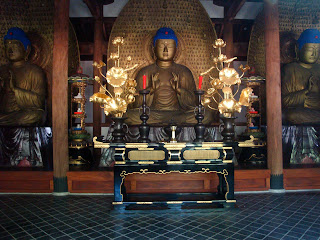 |
| This copy of the Heart Sutra was made in the 8th or 9th century, from the collection of TNM |
Copying scriptures
Sutra copying is a time-honored practice that goes back to the days when there were no copy machines, and even the ability to read and write was in short supply. I have made sutra copies on various occasions in the past but I just joined a new group that meets once a month, so I will be doing it more regularly, I hope. Having seen several procedures for how to do it, I thought I would write about some of the common elements of the copying practice.
In the old days, donating a copy to a temple was a pretty big deal. Nowadays in Japan, it has become a way for lay people to deepen their practice. I don't know if sutra copying is common among lay people in Theravada traditions; please comment if you know that Theravadists also do this. In Japan, sutra copying is related to the seal/stamp/chop culture, imported from China along with the Chinese writing system. In the old days, when someone donated a sutra copy, the temple would stamp its elaborate official seal as a kind of receipt acknowledging the donation. In Japan, that evolved to the point where many temples now offer the seal impression in return for a monetary donation. This is called 'go shu in' ご朱印 literally 'red stamp.' Many people collect them in special albums constructed with accordion-folded paper and hard boards as covers. The most common pattern: a central red stamp represents the main object of worship of the temple. In the case of mikkyo (Buddhist temples of the esoteric tradition), this is likely to be a Sanskrit letter. Another stamp near the upper right corner shows the name of the temple, along with characters referring to a donation. In the lower left is the official stamp of the temple. Then, the name of the Buddhist deity is written with ink down the center of the page, while the name of the temple and the date are added, usually near the corners. The people doing this writing are often skilled calligraphers, so having a 'go shu in' collection can be impressive in terms of both the calligraphy and interesting aspects of the elaborate stamps. For Buddhists, these collections are considered to be an embodiment of Buddhism, so the albums are treated respectfully and often kept on the home altar.

However, I recently visited a temple where you have to make an actual sutra donation in order to get a stamp!! So, this brings us back to the main topic of sutra copying. As you might expect, there is a special procedure for this. Essentially, the idea is to purify oneself and the room, invoke the Triple Gem, do the copy, and dedicate the merit. In more detail:
1) Clean the room and purify (usually incense and candles)
2) Make sure your clothes are clean, appropriate and put on properly
3) Wash hands and face, rinse mouth (toothbrushing also good!) as personal purification
4) Arrange a table with the tools: copying paper, writing brush, paperweight, water dropper (for ink grinding), grinding stone, ink block etc.
5) Bow and invoke the Triple Gem: The Law, the Buddha, the Sangha
6) Sit down properly
7) Read through the sutra aloud
8) Think of your wish or purpose for copying
9) Copy the sutra, maintaining a pure and selfless mind
10) Write your wish and your name/date
11) Dedicate merit to all living beings
12) You may now leave the room.
 |
| This is a special way of collecting temple stamps. This shows one stamp from each temple on a pilgrimage route--this one dedicated to the Bodhisattva Kuan Yin/Kannon |
 |
| Left: Fudo Myo O at the temple Takahata Fudoson. Right: the 1000-arm Kuan Yin, Kiyomizu Do in Ueno Park |
I went to a calligraphy supply shop to buy a writing brush (the temple supplies ink blocks and grinding stones). It is an amazing shop. When you walk in, the smell of ink envelops you--tar, incense and mothballs might be one way to describe it. There are thousands of brushes from China and Japan, as well as paper, ink (liquid and block), grinding stones, brush racks, stones and tools for carving your own stamp--it goes on and on. There was a section for sutra copying paper, and displayed on the wall was a very special sutra copy. It was very beautiful paper, flecked with gold, and there was a gold lotus flower at the bottom of each character space--each character is a Buddha in a way, sitting on a lotus throne. The inscription indicated it was by a 70-year-old woman, who was praying for someone's recovery from illness. The letters were written so perfectly and beautifully it could take your breath away.
 |
| I made this copy as part of a campaign for 10,000 sutra copies shortly after the Fukushima Tohoku disaster |
I think there is a lot to be gained by copying scriptures. I hope that there are also non-Buddhists pursuing copying as a spiritual exercise. Please comment if you have experience or stories along these lines.

















































